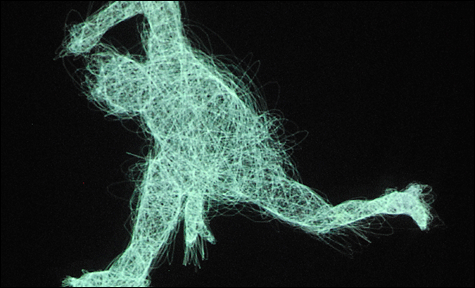
STRING BEINGS The “intelligent video processing” looked a lot like plain old motion capture. |
Two local choreographers have been experimenting with new forms and formats for their work. We got to see the results last weekend in Lorraine Chapman’s The Floating World at Green Street Studios and Martha Mason/Snappy Dance Theater’s String Beings at the Boston Center for the Arts’ Calderwood Pavilion. (The latter continues through this Sunday.) Neither piece was billed as a work-in-progress, but both had a provisional look despite their expert staging.
Lorraine Chapman acknowledges two sources for The Floating World, neither one linked to the sophisticated and illicit popular culture that flourished under that rubric in 18th- and 19th-century Japan. She identifies T.S. Eliot’s desolate 1925 poem “The Hollow Men” and Kurt Jooss’s great ballet of diplomatic stalemate and the triumph of Death, The Green Table. Chapman seems to connect these in history, though The Green Table wasn’t choreographed until 1932, and she assumes the Erik Satie piano pieces that accompany much of her dance were also composed “around the same time.” In fact, the Trois gymnopédies were published in 1887-’88, the Trois morceaux en forme de poire in 1903.
Chapman’s casual attributions indicate to me that she didn’t really base her dance on these cultural icons but wanted to help the audience think its way into what amounted to an hour of movement studies. I don’t know whether her contact with Rudolf Laban’s Eukinetics has been any less cursory, but she credits that as the basis of the choreography.
Rudolf Laban, the great movement theorist of the 20th century, was the founder of German modern dance and the teacher of Kurt Jooss, Mary Wigman, and a generation of pre–World War II choreographers. Eukinetics, one branch of Laban’s lifelong research into the expressive baselines of human movement, was not, as Chapman asserts, an “applied system of controlled body movement.” Laban distinguished certain dynamic tendencies that accompany all movement, and he theorized that the dancer, consciously or unconsciously, can bring these qualities into play. In timing a step or a gesture between the polar extremes of quickness and slowness, for instance, she can shade an otherwise neutral action with more or less urgency.
As taught in this country since the 1960s, Eukinetics underlies the system of Effort-Shape, which is now called Labananalysis. In Eukinetics, Chapman seems to have sought a structured way of making up new movement. Her dancers created their own phrases, then improvised to infuse them with various qualities identified by Laban. What they came up with preserved the dancers’ original phrase material but allowed individual differences to matter.
The six dancers sat motionless in chairs facing the same diagonal in the middle of the Green Street space as the audience entered to take seats along two sides. For a long time we listened to white noise (soundscore by Alan Sutherland): wind, a low drone, muted voices, machines, a nursery tune. I guess we were meant to charge up our memory banks.